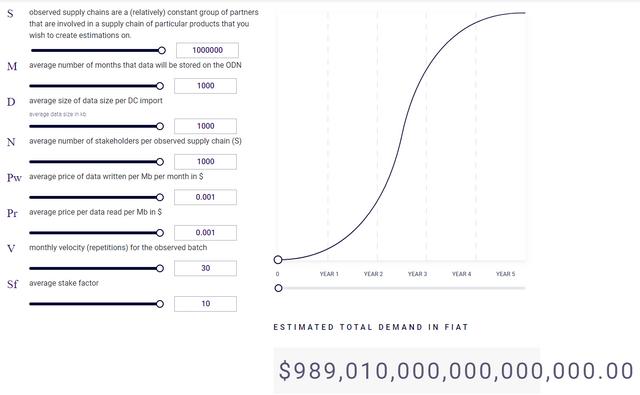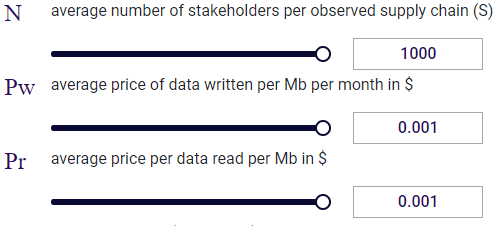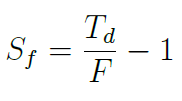Why You Should Care
OriginTrail's token demand model (TDM) is a industry-first for the crypto space. Without independent analysis, we rely on white papers, project founders, YouTubers, community admins, or someone generally unqualified and/or with a conflict of interest to determine the value of a project token. It is reasonable to expect that, most project founders believe their coin/token to be the next greatest thing (of course they would!). OriginTrail has committed to seeking the skills and expertise of a bona fide third party for the purposes of resolving reliance on statements generated from conflicts of interest and/or from persons unqualified in the practice of demand modeling. If you are reading this post, I assume you have some interest in the potential future price of OriginTrail's TRAC token. The TDM is OriginTrail's attempt at providing confidence and transparency to you as an interested party. Try finding another crypto project willing to assume such a vulnerable position in an effort to provide confidence to stakeholders.
The Intent
The intent of this article is to describe to as broad an audience as possible the current status of the TDM in a qualitative manner. I will not be attempting to nail down spot prices, future prices, or explicitly define any of the variables the TDM uses to generate time-dependent token demand. I am capable of doing all sorts of speculative tricks with the TDM, but this would be an exercise in complete guesswork. I do not believe any such analysis from me in this regard would be worth investing your time in reading. I simply hope to explain to the community how I have interpreted the message contained within the formulas that comprise the TDM.
This article is intended as a living document, which aims to serve as a repository for questions, concerns, and comments specific to the TDM. Initially, I hope this article will be a conversation starter. I am relying on your participation to be successful. So be honest, be critical, be persistent, and demand that your questions be answered sufficiently well. I am here to help you make informed decisions concerning OriginTrail. This analysis will only be as robust as the feedback I receive from the community.
Call for Questions, Criticism, and Commentary
If, by the conclusion of this article, you remain to be unsure of some component of the TDM, please submit your request via reply and I will entertain addressing all thoughtful and serious queries. Although I have focused on explaining the TDM in a generally approachable way, I suspect certain members of the community will be dissatisfied with the depth of this initial analysis. As such, I encourage anyone looking for a deeper understanding of the model to reply with those requests. I believe I can take this analysis as far as anyone would request (n-dimensional Jacobians, anyone?), and would be glad to demonstrate this claim. Come at me! Let's build a conversation around the TDM that allows almost everyone to have their questions answered to satisfaction.
TRAC Tokens Will Be Worth ~2 Billion USD Each!?

No. They won't...ever. How did I even come up with such a figure? The maximum circulating supply of TRAC tokens is 500,000,000. If one divides the token demand value shown above by 500,000,000.00, one will see that the current version of the TDM allows for this. This should not be taken seriously, and motivates my previous claims concerning the futility of trying to assign a quantitative analysis within the ranges provided for the input variable.
If It Isn't Realistic, Why Did the Team Provide Us the Ability to Arrive at Such a Value for Token Demand?
I don't know and I don't suspect the team would argue the legitimacy of considerations that include nearly 2B USD per TRAC token. The current version of the TDM, as stated on the OriginTrail website, is unrefined in its limits. This does not mean, however, that the analysis is faulty. In fact, it may be entirely accurate for realizable values assigned to input variables. I suspect the current limits on variables will be constrained in the near future, which should most likely bring the upper limits of token demand into a realistic range. Let's not get too carried away in this, as it is likely a variable constraint issue rather than model invalidation.
The Equations

The Force Function
The equations shown above may appear complex at first glance, but let's do some clever things to make them look a bit more approachable. Let's see if we can simplify what we are looking at.





If you're still with me, we just caused the token demand force expression, F, to look much simpler and more approachable without losing any of the information. This may give pause for some. If so, now is the time to reply to this post and let me know what went wrong. We're moving on for now.
We don't really have to stop there. We can do more. Let's focus on B + C. Now that we have no idea what they are anymore, let's just see if we can sort of forget them altogether. Recall the upper limits on the variables that make up B and C in our simplified expression, as shown below.

Let's just throw these maximum values into the expressions and see what happens.

So, in the maximum limit (which we previously stated is likely not to be taken seriously for the moment), B + C equals 2.997. Consider that the value S from expression A has an upper limit of 1,000,000 and it quickly becomes obvious that, in a relative sense, the B + C expression is important but not the driving force in the determination of F. This result assumes cloud computing costs associated with reading and writing data are generally similar, which is a decent assumption for the purposes of this analysis. Now, keeping in mind that the maximum value of B + C is less than 3 and S can assume a maximum value of 1,000,000, we can safely say B + C matters but not a lot.
(aside: Yes, I did say the upper limits on the variable are likely not based in reality. That is a blanket statement and crude. The line of reasoning I am using here is that, if the maximum value of S is invalid, the maximum values for n, Pw, and Pr are proportionally invalid. Maybe it's a poor assumption, but when you get into a regime for which n, Pw, Pr begin to dominate the token demand, you can assume OriginTrail is irrelevant.)
Are you still here? The main influence on the token demand force function is the expression A. So, we should probably look at A again and see what constitutes the expression.
The General Variables
OriginTrail has defined the variables in expression A, shown below as a reminder, as general variables.

Now that we have reduced the token demand force function to expression A, we should probably figure out what these general variables are. In their Medium post(https://medium.com/origintrail/the-driving-forces-of-the-trace-ecosystem-e2cb4454c6e1), the OriginTrail team has done a superb job of explaining each of the variables in A, and I am not going to try to improve their definitions. I just want to consider how we might describe how these variables can be grouped together.
Rehearsing briefly (refer to the Medium article if you want more explanation), S is the number of supply chains, n is the average number of stakeholders associated with those supply chains, M is the average number of months an agreement remains valid, D is the size of the data being generated as products or information moves through the supply chains, and V is the rate at which data is written and/or read per month. That's still a lot of moving parts, but I think I can summarize.
Basically, expression A is a measure of how many ODN participants exist, the breadth and scope of those participants' supply chains, how much data they are creating, and how often they are accessing that data. Surprise! We have just concluded that, the predominant factors associated with the token demand force function, F, are all associated with the how many participants and to what extent use the ODN. You probably knew this all along. You may even be let down. Don't be. We're not done yet. And we still haven't answered the burning question those of you whom have made it this far are asking - 'What do I get out of the deal?'.
Token Demand
In the previous section, we basically discovered that the token demand force function depends on how many entities use the ODN and to what extent. I am assuming there is not much more to be done, for the moment, in the determination of token demand, now that we know what F is. As a reminder, token demand is defined below.

It seems we have everything we need except this nebulous staking factor term, Sf. The equation for token demand, Td, states that token demand is the additive quantity of the token demand force function and the token demand force function multiplied by the staking factor. This implies, as the staking factor is defined to be only positive values (check my work if you don't believe me), that token demand will increase as a function of increases in the staking factor, Sf. Okay. But, what would cause token demand to increase generally?
I propose that, as the variable name suggests, the number of tokens staked would be directly proportional to token scarcity. That is, by locking up TRAC tokens in agreements via staking, there will be fewer TRAC tokens available to buy on the market. Economic theory suggests this would cause increase in the fiat-denominated component of token demand. In other words, the price will go up. That makes sense to me. So what?
Speculation Concerning Staking Incentives
As an exercise left to the reader, it can be shown that:

Mooorrree math? Yeah, and this is the whole point you're reading, I'll bet. This expression will provide to you some insight concerning what kind of return on stake a node operator might expect to receive as a function of token demand. As Sf represents the rate of staking, we can get a feel for the underlying factors associated with staking incentives, if we make the assumption that the number of tokens staked will be directly proportional to the incentives node operators receive. Makes sense, right? If you don't receive much return on stake, you probably won't stake. Simple.
We qualitatively figured out how the token demand force function, F, would increase. We also looked at how the value of F impacts overall token demand, assuming a certain staking factor. So, Now is the time to deliver the likely very disappointing news.
Token demand will depend almost entirely on how many entities use the ODN, and to what extent. Beyond that, token demand will depend on the circulating supply of TRAC tokens, or - said another way - the amount of staked tokens, which will be necessarily removed from the functional circulating supply. Node incentives concerning return on stake will be solely a function of the market dynamics between token demand and node supply.
That's it.
What Do I Think About the Token Demand Model?
The token demand model is reflective of the OriginTrail team, and their recognition of the need for independent evaluation concerning token demand. On this point, I can't say enough about the team and their willingness to be trend setters. The team are not following examples by others, but asking where the value is, and going for it. I can't say enough about how unique this is in the crypto space. However, it isn't perfect. It's important to remember it wasn't presented as being final, and we are still awaiting some information to be released concerning feedback the team has received on the model. As I don't want you to have participated to this extent and come away with nothing new, I will provide some of my own personal thoughts.
The Limits on the Input Variables Need to be Constrained
As I shared initially, the current token demand model input parameters, and their ranges, allow for a theoretical per TRAC token price of ~ 2B USD. Ain't happening. The range of theoretical values for TRAC tokens includes 0.00 - ~2.0B USD. That's not very helpful at the moment. Additionally, the input parameters permit the existence of negative values for the TRAC token. Unless you are margin trading, you are not going to wind up bankrupt by owning TRAC tokens. Personally, I think you are going to enjoy owning them, but you aren't going to become the world's wealthiest person by owning 70 TRAC tokens. I suspect the team will constrain these values to be reasonable in time. It's important to remember the team is busy and this model only works for a real market for TRAC tokens, which won't exist until mainnet launch in September.
Positive Correlation between Cloud Computing Costs and Token Demand
The TDM currently assigns positive correlation between cloud computing costs and and token demand generally. To me, this is paradoxical. Perhaps the assumption is that, businesses can offset its exposure to rising cloud computing costs by using the ODN. If so, I think it is a false assumption. In such an event, node operators would initially absorb the rising costs of cloud computing, which would be reflected in their willingness to stake tokens. Those incurred costs would be passed on immediately to the businesses attempting to avoid those costs in the first place. I simply don't think increases in cloud computing will translate to increase token demand. If anything, I suspect decreases in cloud computing will increase token demand. Consider the case in which cloud computing services are free. Does that mean the TRAC token has zero demand? I don't think so. Cloud computation and storage services are not really associated with the value of the ODN, but more of an underlying factor associated with costs of using the ODN generally.
Closing Remarks
I do not work for OriginTrail, and I am not a professional cryptoeconomist. These views are my own, and I intend them to be taken as such. I hope this document marks the beginning of a community discussion, rather than an end. I haven't really elucidated anything new, beyond showing the qualitative and relative factors associated with the token demand model. I look forward to receiving feedback. I intend to answer all questions posed in sincerity and sufficient detail.
thank you very much for this :)
did they update their model by now?
Downvoting a post can decrease pending rewards and make it less visible. Common reasons:
Submit
I believe the model remains as it was when I performed the analysis.
Downvoting a post can decrease pending rewards and make it less visible. Common reasons:
Submit
Since 2013, OriginTrail has Been solving different problems and efficiency that SupplyChain has. They have all the capabilities and the quality to be called as one of the most underrated cryptocurrency.
http://www.hodlerxl.com/origintrail/origintrail-trac-takes-part-in-the-european-agri-food-sector/
Downvoting a post can decrease pending rewards and make it less visible. Common reasons:
Submit